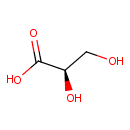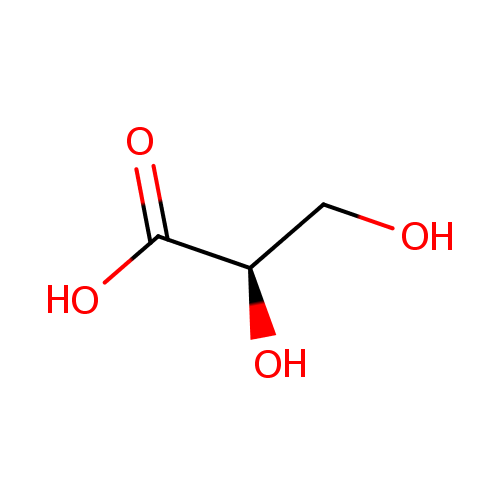
Glyceric acid (PAMDB000597)
| Record Information | |||||||||||||||||||||||||||||||||||||||||||||||||||||||||||||
|---|---|---|---|---|---|---|---|---|---|---|---|---|---|---|---|---|---|---|---|---|---|---|---|---|---|---|---|---|---|---|---|---|---|---|---|---|---|---|---|---|---|---|---|---|---|---|---|---|---|---|---|---|---|---|---|---|---|---|---|---|---|
| Version | 1.0 | ||||||||||||||||||||||||||||||||||||||||||||||||||||||||||||
| Update Date | 1/22/2018 11:54:54 AM | ||||||||||||||||||||||||||||||||||||||||||||||||||||||||||||
| Metabolite ID | PAMDB000597 | ||||||||||||||||||||||||||||||||||||||||||||||||||||||||||||
| Identification | |||||||||||||||||||||||||||||||||||||||||||||||||||||||||||||
| Name: | Glyceric acid | ||||||||||||||||||||||||||||||||||||||||||||||||||||||||||||
| Description: | Glyceric acid is a colorless syrupy acid, obtained from oxidation of glycerol. It is a natural three-carbon sugar acid. Salts and esters of glyceric acid are known as glycerates. Several phosphate derivatives of glyceric acid, including 2-phosphoglyceric acid, 3-phosphoglyceric acid, 2,3-bisphosphoglyceric acid, and 1,3-bisphosphoglyceric acid, are important biochemical intermediates. (Wikipedia) | ||||||||||||||||||||||||||||||||||||||||||||||||||||||||||||
| Structure | |||||||||||||||||||||||||||||||||||||||||||||||||||||||||||||
| Synonyms: |
| ||||||||||||||||||||||||||||||||||||||||||||||||||||||||||||
| Chemical Formula: | C3H6O4 | ||||||||||||||||||||||||||||||||||||||||||||||||||||||||||||
| Average Molecular Weight: | 106.0773 | ||||||||||||||||||||||||||||||||||||||||||||||||||||||||||||
| Monoisotopic Molecular Weight: | 106.02660868 | ||||||||||||||||||||||||||||||||||||||||||||||||||||||||||||
| InChI Key: | RBNPOMFGQQGHHO-UWTATZPHSA-N | ||||||||||||||||||||||||||||||||||||||||||||||||||||||||||||
| InChI: | InChI=1S/C3H6O4/c4-1-2(5)3(6)7/h2,4-5H,1H2,(H,6,7)/t2-/m1/s1 | ||||||||||||||||||||||||||||||||||||||||||||||||||||||||||||
| CAS number: | 473-81-4 | ||||||||||||||||||||||||||||||||||||||||||||||||||||||||||||
| IUPAC Name: | (2R)-2,3-dihydroxypropanoic acid | ||||||||||||||||||||||||||||||||||||||||||||||||||||||||||||
| Traditional IUPAC Name: | glycerate | ||||||||||||||||||||||||||||||||||||||||||||||||||||||||||||
| SMILES: | OC[C@@H](O)C(O)=O | ||||||||||||||||||||||||||||||||||||||||||||||||||||||||||||
| Chemical Taxonomy | |||||||||||||||||||||||||||||||||||||||||||||||||||||||||||||
| Taxonomy Description | This compound belongs to the class of organic compounds known as sugar acids and derivatives. These are compounds containing a saccharide unit which bears a carboxylic acid group. | ||||||||||||||||||||||||||||||||||||||||||||||||||||||||||||
| Kingdom | Organic compounds | ||||||||||||||||||||||||||||||||||||||||||||||||||||||||||||
| Super Class | Organooxygen compounds | ||||||||||||||||||||||||||||||||||||||||||||||||||||||||||||
| Class | Carbohydrates and carbohydrate conjugates | ||||||||||||||||||||||||||||||||||||||||||||||||||||||||||||
| Sub Class | Sugar acids and derivatives | ||||||||||||||||||||||||||||||||||||||||||||||||||||||||||||
| Direct Parent | Sugar acids and derivatives | ||||||||||||||||||||||||||||||||||||||||||||||||||||||||||||
| Alternative Parents | |||||||||||||||||||||||||||||||||||||||||||||||||||||||||||||
| Substituents |
| ||||||||||||||||||||||||||||||||||||||||||||||||||||||||||||
| Molecular Framework | Aliphatic acyclic compounds | ||||||||||||||||||||||||||||||||||||||||||||||||||||||||||||
| External Descriptors |
| ||||||||||||||||||||||||||||||||||||||||||||||||||||||||||||
| Physical Properties | |||||||||||||||||||||||||||||||||||||||||||||||||||||||||||||
| State: | Liquid | ||||||||||||||||||||||||||||||||||||||||||||||||||||||||||||
| Charge: | -1 | ||||||||||||||||||||||||||||||||||||||||||||||||||||||||||||
| Melting point: | Not Available | ||||||||||||||||||||||||||||||||||||||||||||||||||||||||||||
| Experimental Properties: |
| ||||||||||||||||||||||||||||||||||||||||||||||||||||||||||||
| Predicted Properties |
| ||||||||||||||||||||||||||||||||||||||||||||||||||||||||||||
| Biological Properties | |||||||||||||||||||||||||||||||||||||||||||||||||||||||||||||
| Cellular Locations: | Cytoplasm | ||||||||||||||||||||||||||||||||||||||||||||||||||||||||||||
| Reactions: | Tartronate semialdehyde + Hydrogen ion + NADH <> Glyceric acid + NAD Hydrogen ion + Hydroxypyruvic acid + NADH > Glyceric acid + NAD Hydrogen ion + Hydroxypyruvic acid + NADPH > Glyceric acid + NADP Adenosine triphosphate + Glyceric acid > 3-Phosphoglycerate + ADP + Hydrogen ion Adenosine triphosphate + Glyceric acid > 2-Phospho-D-glyceric acid + ADP + Hydrogen ion Adenosine triphosphate + Glyceric acid <> ADP + 3-Phospho-D-glycerate Glyceric acid + NADP <> Tartronate semialdehyde + NADPH + Hydrogen ion Tartaric acid <> Glyceric acid + Carbon dioxide 2(alpha-D-Mannosyl-6-phosphate)-D-glycerate + Water > Mannose 6-phosphate + Glyceric acid NAD(P)<sup>+</sup> + Glyceric acid < NAD(P)H + Tartronate semialdehyde + Hydrogen ion Glyceric acid + NAD(P)(+) > Tartronate semialdehyde + NAD(P)H Glyceric acid + NAD(P)(+) > Hydroxypyruvic acid + NAD(P)H Adenosine triphosphate + Glyceric acid > ADP + 2-Phospho-D-glyceric acid 2-O-(6-Phospho-alpha-D-mannosyl)-D-glycerate + Water > Mannose 6-phosphate + Glyceric acid Glyceric acid + NAD + NADP <> Tartronate semialdehyde + NADH + NADPH + Hydrogen ion More...Tartronate semialdehyde + Hydrogen ion + NADPH + NADPH > NADP + Glyceric acid Glyceric acid + Adenosine triphosphate > Hydrogen ion + Adenosine diphosphate + 2-Phosphoglyceric acid + ADP + 2-Phosphoglyceric acid Glyceric acid + Adenosine triphosphate > Adenosine diphosphate + Hydrogen ion + 3-Phosphoglyceric acid + ADP + 3-Phosphoglycerate | ||||||||||||||||||||||||||||||||||||||||||||||||||||||||||||
| Pathways: | |||||||||||||||||||||||||||||||||||||||||||||||||||||||||||||
| Spectra | |||||||||||||||||||||||||||||||||||||||||||||||||||||||||||||
| Spectra: | |||||||||||||||||||||||||||||||||||||||||||||||||||||||||||||
| References | |||||||||||||||||||||||||||||||||||||||||||||||||||||||||||||
| References: |
| ||||||||||||||||||||||||||||||||||||||||||||||||||||||||||||
| Synthesis Reference: | Kyriacou, Demetrios; Tougas, Terrence P. Preparation of glyceric acid by anodic oxidation of glycerol at a silver oxide electrode. Journal of Organic Chemistry (1987), 52(11), 2318-19. | ||||||||||||||||||||||||||||||||||||||||||||||||||||||||||||
| Material Safety Data Sheet (MSDS) | Download (PDF) | ||||||||||||||||||||||||||||||||||||||||||||||||||||||||||||
| Links | |||||||||||||||||||||||||||||||||||||||||||||||||||||||||||||
| External Links: |
| ||||||||||||||||||||||||||||||||||||||||||||||||||||||||||||
Enzymes
- General function:
- Involved in glycerate kinase activity
- Specific function:
- ATP + (R)-glycerate = ADP + 3-phospho-(R)- glycerate
- Gene Name:
- garK
- Locus Tag:
- PA1052
- Molecular weight:
- 38.6 kDa
Reactions
| ATP + (R)-glycerate = ADP + 3-phospho-(R)-glycerate. |
- General function:
- Involved in oxidoreductase activity, acting on the CH-OH group of donors, NAD or NADP as acceptor
- Specific function:
- Catalyzes the NADPH-dependent reduction of glyoxylate and hydroxypyruvate into glycolate and glycerate, respectively. Can also reduce 2,5-diketo-D-gluconate (25DKG) to 5-keto-D- gluconate (5KDG), 2-keto-D-gluconate (2KDG) to D-gluconate, and 2- keto-L-gulonate (2KLG) to L-idonate (IA), but it is not its physiological function. Inactive towards 2-oxoglutarate, oxaloacetate, pyruvate, 5-keto-D-gluconate, D-fructose and L- sorbose. Activity with NAD is very low
- Gene Name:
- ghrB
- Locus Tag:
- PA2263
- Molecular weight:
- 35.6 kDa
Reactions
| Glycolate + NADP(+) = glyoxylate + NADPH. |
| D-glycerate + NAD(P)(+) = hydroxypyruvate + NAD(P)H. |
| D-gluconate + NADP(+) = 2-dehydro-D-gluconate + NADPH. |
- General function:
- Involved in 3-hydroxyisobutyrate dehydrogenase activity
- Specific function:
- (R)-glycerate + NAD(P)(+) = 2-hydroxy-3- oxopropanoate + NAD(P)H
- Gene Name:
- glxR
- Locus Tag:
- PA1500
- Molecular weight:
- 30.9 kDa
Reactions
| D-glycerate + NAD(P)(+) = 2-hydroxy-3-oxopropanoate + NAD(P)H. |

